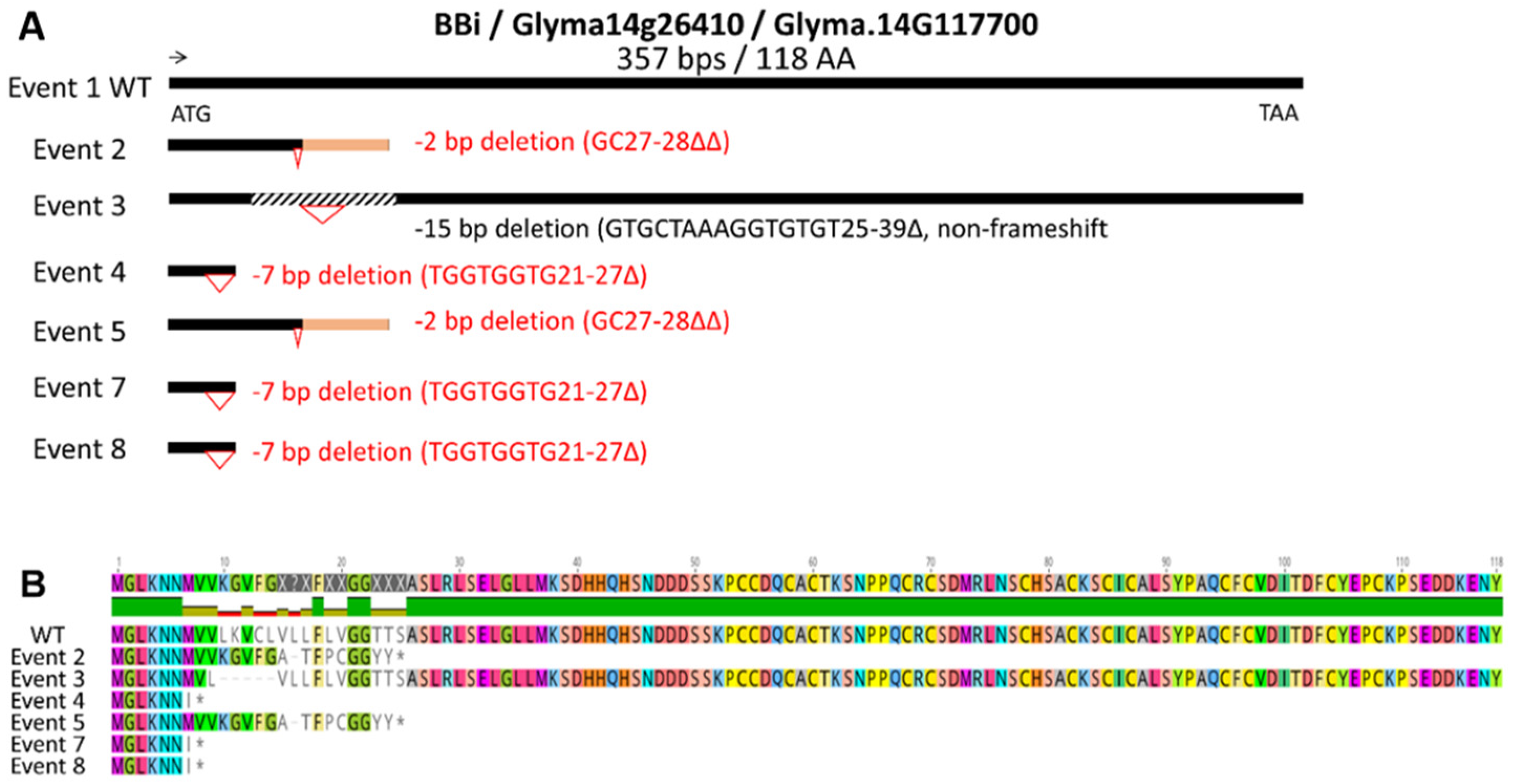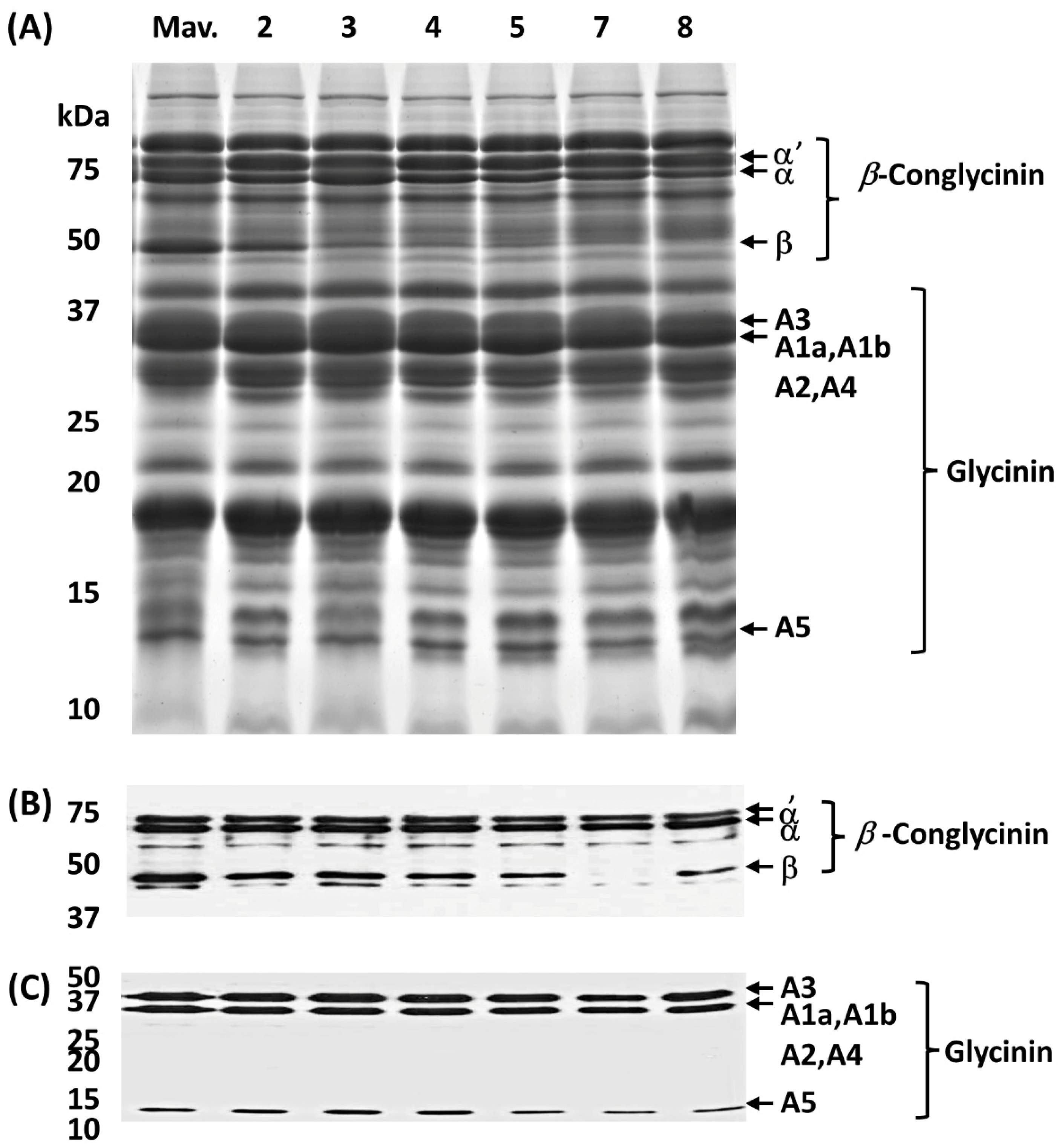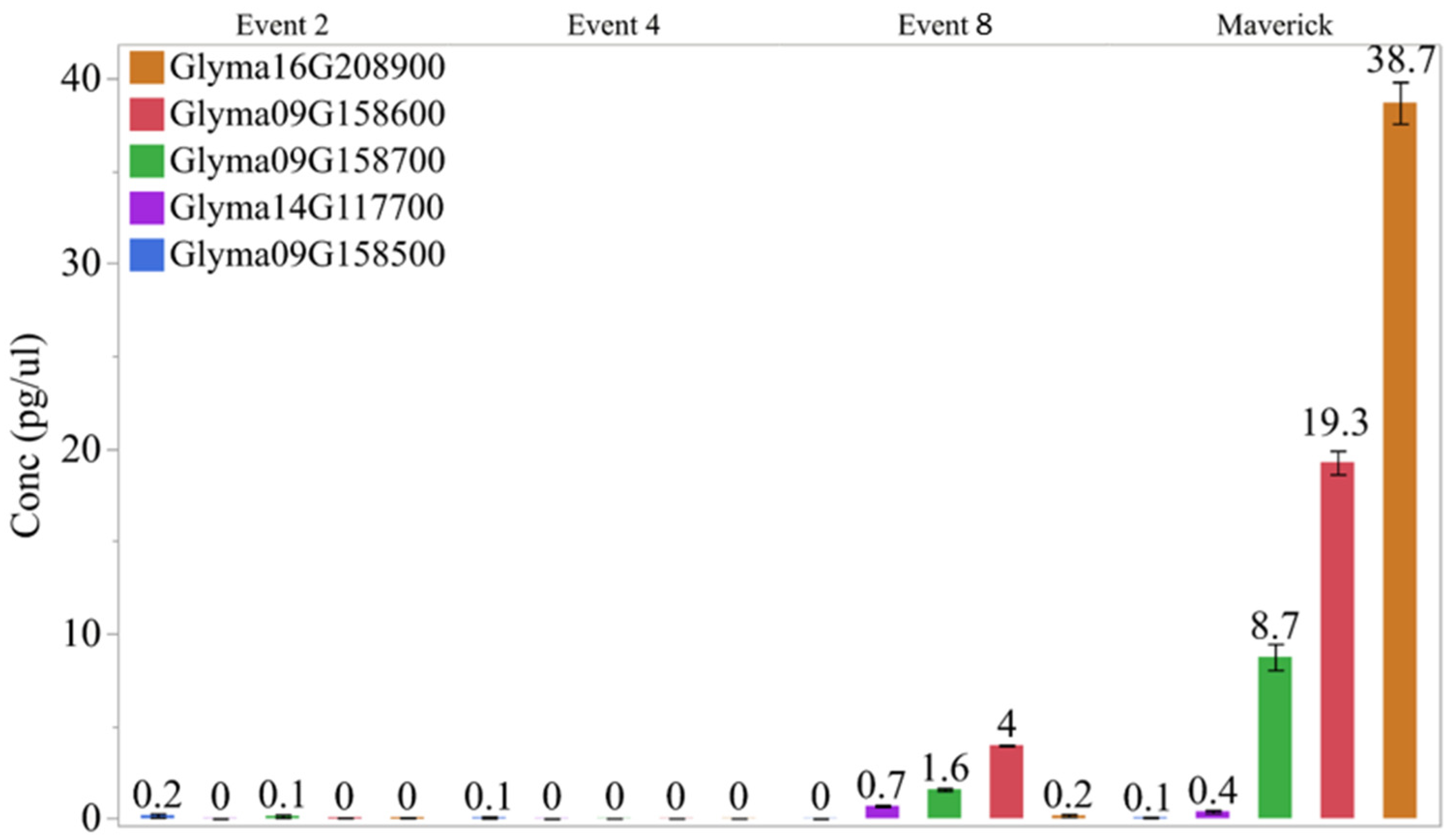Bowman–Birk Inhibitor Mutants of Soybean Generated by CRISPR-Cas9 Reveal Drastic Reductions in Trypsin and Chymotrypsin Inhibitor Activities
Abstract
1. Introduction
2. Results
2.1. Generation of BBi Mutants by CRISPR/Cas9 Gene Editing
2.2. SDS-PAGE Analysis of Seed Proteins of CRISPR/Cas9 Transgenic Plants
2.3. Immunoblot Analysis Reveals the Absence of BBi in the Seeds of Transgenic BBi Mutants
2.4. Chymotrypsin and Trypsin Inhibitor Activities Are Drastically Reduced in CRISPR/Cas9 Gene-Edited Transgenic BBi Mutants
2.5. qRT-PCR Analysis Confirms the Absence of Expression of the Abundant BBi Genes in CRISPR/Cas9 Gene-Edited Transgenic BBi Mutants
3. Discussion
4. Materials and Methods
4.1. Chemicals
4.2. Analysis of Expression of BBi Genes Using Public Data Repositories
4.3. Generation of CRISPR/CAS9-Induced BBi Knockout Soybean Mutants
4.4. Soybean Transformation
4.5. Protein Extraction and 1-D Electrophoresis
4.6. Real-Time qRT-PCR Analysis of BBi Genes in Developing Soybean Seeds
4.7. Screening of Putative Transgenic Plants and Identification of CRISPR-CAS9-Induced Mutations
4.8. Immunoblot Analysis
4.9. Trypsin and Chymotrypsin Inhibitor Assay
Supplementary Materials
Author Contributions
Funding
Institutional Review Board Statement
Informed Consent Statement
Data Availability Statement
Acknowledgments
Conflicts of Interest
References
- Bullock, D.G. Crop rotation. Crit. Rev. Plant Sci. 1992, 11, 309–326. [Google Scholar] [CrossRef]
- Mohammad Sohidul, I.; Imam, M.; Islam, M.R.; Hasan, M.K.; Hafeez, A.S.M.G.; Hosen, M.M.; Saneoka, H.; Ueda, A.; Liu, L.; Naz, M.; et al. Soybean and Sustainable Agriculture for Food Security. In Soybean; Takuji, O., Yoshihiko, T., Norikuni, O., Takashi, S., Sayuri, T., Eds.; IntechOpen: Rijeka, Croatia, 2022; Chapter 1. [Google Scholar] [CrossRef]
- Ruiz, N.; Parsons, C.; Stein, H.; Coon, C.; Eys, J.; Miles, R. A Review: 100 Years of Soybean Meal; ADM: Chicago, IL, USA, 2020. [Google Scholar]
- Vorster, J.; van der Westhuizen, W.; du Plessis, G.; Marais, D.; Sparvoli, F.; Cominelli, E.; Camilli, E.; Ferrari, M.; Le Donne, C.; Marconi, S.; et al. In order to lower the antinutritional activity of serine protease inhibitors, we need to understand their role in seed development. Front. Plant Sci. 2023, 14, 1252223. [Google Scholar] [CrossRef] [PubMed]
- Kunitz, M. Crystalline Soybean Trypsin Inhibitor: II. General Properties. J. Gen. Physiol. 1947, 30, 291–310. [Google Scholar] [CrossRef] [PubMed]
- Bowman, D.E. Fractions derived from soy beans and navy beans which retard tryptic digestion of casein. Proc. Soc. Exp. Biol. Med. 1944, 57, 139–140. [Google Scholar] [CrossRef]
- DiPietro, C.M.; Liener, I.E. Heat inactivation of the Kunitz and Bowman-Birk soybean protease inhibitors. J. Agric. Food Chem. 1989, 37, 39–44. [Google Scholar] [CrossRef]
- Jofuku, K.D.; Schipper, R.D.; Goldberg, R.B. A frameshift mutation prevents Kunitz trypsin inhibitor mRNA accumulation in soybean embryos. Plant Cell 1989, 1, 427–435. [Google Scholar] [PubMed]
- Krishnan, H.B. Characterization of a soybean [Glycine max (L.) Merr.] mutant with reduced levels of Kunitz trypsin inhibitor. Plant Sci. 2001, 160, 979–986. [Google Scholar] [CrossRef]
- Orf, J.; Hymowitz, T. Inheritance of the Absence of the Kunitz Trypsin Inhibitor in Seed Protein of Soybeans 1. Crop Sci. 1979, 19, 107–109. [Google Scholar] [CrossRef]
- Palacios, M.; Easter, R.; Soltwedel, K.; Parsons, C.; Douglas, M.; Hymowitz, T.; Pettigrew, J. Effect of soybean variety and processing on growth performance of young chicks and pigs. J. Anim. Sci. 2004, 82, 1108–1114. [Google Scholar] [CrossRef] [PubMed]
- Bernard, R.L.; Hymowitz, T.; Cremeens, C.R. Registration of ‘Kunitz’ Soybean. Crop Sci. 1991, 31, 232–233. [Google Scholar] [CrossRef]
- Gillman, J.D.; Kim, W.-S.; Krishnan, H.B. Identification of a new soybean kunitz trypsin inhibitor mutation and its effect on bowman− birk protease inhibitor content in soybean seed. J. Agric. Food Chem. 2015, 63, 1352–1359. [Google Scholar] [CrossRef] [PubMed]
- Kollipara, K.P.; Singh, R.J.; Hymowitz, T. Inheritance of Protease Inhibitors in Glycine tomentella Hayata (2n = 38), a Perennial Relative of Soybean. J. Hered. 1996, 87, 461–463. [Google Scholar] [CrossRef][Green Version]
- Livingstone, D.; Beilinson, V.; Kalyaeva, M.; Schmidt, M.A.; Herman, E.M.; Nielsen, N.C. Reduction of protease inhibitor activity by expression of a mutant Bowman-Birk gene in soybean seed. Plant Mol. Biol. 2007, 64, 397–408. [Google Scholar] [CrossRef] [PubMed]
- Cong, L.; Ran, F.A.; Cox, D.; Lin, S.; Barretto, R.; Habib, N.; Hsu, P.D.; Wu, X.; Jiang, W.; Marraffini, L.A. Multiplex genome engineering using CRISPR/Cas systems. Science 2013, 339, 819–823. [Google Scholar] [CrossRef] [PubMed]
- Mali, P.; Yang, L.; Esvelt, K.M.; Aach, J.; Guell, M.; DiCarlo, J.E.; Norville, J.E.; Church, G.M. RNA-guided human genome engineering via Cas9. Science 2013, 339, 823–826. [Google Scholar] [CrossRef] [PubMed]
- Liu, J.; Gunapati, S.; Mihelich, N.T.; Stec, A.O.; Michno, J.M.; Stupar, R.M. Genome Editing in Soybean with CRISPR/Cas9. Methods Mol. Biol. 2019, 1917, 217–234. [Google Scholar] [CrossRef] [PubMed]
- Sun, X.; Hu, Z.; Chen, R.; Jiang, Q.; Song, G.; Zhang, H.; Xi, Y. Targeted mutagenesis in soybean using the CRISPR-Cas9 system. Sci. Rep. 2015, 5, 10342. [Google Scholar] [CrossRef] [PubMed]
- Severin, A.J.; Woody, J.L.; Bolon, Y.-T.; Joseph, B.; Diers, B.W.; Farmer, A.D.; Muehlbauer, G.J.; Nelson, R.T.; Grant, D.; Specht, J.E.; et al. RNA-Seq Atlas of Glycine max: A guide to the soybean transcriptome. BMC Plant Biol. 2010, 10, 160. [Google Scholar] [CrossRef]
- Krishnan, H.B.; Kim, S.; Pereira, A.E.; Jurkevich, A.; Hibbard, B.E. Adenanthera pavonina, a potential plant-based protein resource: Seed protein composition and immunohistochemical localization of trypsin inhibitors. Food Chem. X 2022, 13, 100253. [Google Scholar] [CrossRef] [PubMed]
- Krishnan, H.B.; Oehrle, N.W.; Natarajan, S.S. A rapid and simple procedure for the depletion of abundant storage proteins from legume seeds to advance proteome analysis: A case study using Glycine max. Proteomics 2009, 9, 3174–3188. [Google Scholar] [CrossRef] [PubMed]
- Dipietro, C.; Liener, I. Soybean protease inhibitors in foods. J. Food Sci. 1989, 54, 606–609. [Google Scholar] [CrossRef]
- He, H.; Li, X.; Kong, X.; Hua, Y.; Chen, Y. Heat-induced inactivation mechanism of soybean Bowman-Birk inhibitors. Food Chem. 2017, 232, 712–720. [Google Scholar] [CrossRef] [PubMed]
- Sexton, P.; Naeve, S.; Paek, N.; Shibles, R. Sulfur availability, cotyledon nitrogen: Sulfur ratio, and relative abundance of seed storage proteins of soybean. Crop Sci. 1998, 38, 983–986. [Google Scholar] [CrossRef]
- Paek, N.C.; Imsande, J.; Shoemaker, R.C.; Shibles, R. Nutritional control of soybean seed storage protein. Crop Sci. 1997, 37, 498–503. [Google Scholar] [CrossRef]
- Holowach, L.P.; Thompson, J.F.; Madison, J.T. Storage protein composition of soybean cotyledons grown in vitro in media of various sulfate concentrations in the presence and absence of exogenous L-methionine. Plant Physiol. 1984, 74, 584–589. [Google Scholar] [CrossRef]
- Gayler, K.R.; Sykes, G.E. Effects of nutritional stress on the storage proteins of soybeans. Plant Physiol. 1985, 78, 582–585. [Google Scholar] [CrossRef]
- Fujiwara, T.; Hirai, M.Y.; Chino, M.; Komeda, Y.; Naito, S. Effects of sulfur nutrition on expression of the soybean seed storage protein genes in transgenic petunia. Plant Physiol. 1992, 99, 263–268. [Google Scholar] [CrossRef] [PubMed]
- Clarke, E.; Wiseman, J. Developments in plant breeding for improved nutritional quality of soya beans I. Protein and amino acid content. J. Agric. Sci. 2000, 134, 111–124. [Google Scholar] [CrossRef]
- BIRK, Y. The Bowman-Birk inhibitor. Trypsin-and chymotrypsin-inhibitor from soybeans. Int. J. Pept. Protein Res. 1985, 25, 113–131. [Google Scholar] [CrossRef] [PubMed]
- Kim, W.-S.; Sun-Hyung, J.; Oehrle, N.W.; Jez, J.M.; Krishnan, H.B. Overexpression of ATP sulfurylase improves the sulfur amino acid content, enhances the accumulation of Bowman–Birk protease inhibitor and suppresses the accumulation of the β-subunit of β-conglycinin in soybean seeds. Sci. Rep. 2020, 10, 14989. [Google Scholar] [CrossRef] [PubMed]
- Orf, J.H. Modifying soybean composition by plant breeding. In Proceedings of the Soybean Utilization Alternatives Conference, University of Minnesota, Minneapolis, NM, USA, 16–18 February 1988. [Google Scholar]
- Čermák, T.; Curtin, S.J.; Gil-Humanes, J.; Čegan, R.; Kono, T.J.Y.; Konečná, E.; Belanto, J.J.; Starker, C.G.; Mathre, J.W.; Greenstein, R.L.; et al. A Multipurpose Toolkit to Enable Advanced Genome Engineering in Plants. Plant Cell 2017, 29, 1196–1217. [Google Scholar] [CrossRef] [PubMed]
- Sleper, D.A.; Nickell, C.D.; Noel, G.R.; Cary, T.R.; Thomas, D.J.; Clark, K.M.; Rao Arelli, A.P. Registration of ‘Maverick’ Soybean. Crop Sci. 1998, 38, 549–550. [Google Scholar] [CrossRef]
- Zeng, P.; Vadnais, D.; Zhang, Z.; Polacco, J. Refined glufosinate selection in Agrobacterium-mediated transformation of soybean [Glycine max (L.) Merrill]. Plant Cell Rep. 2004, 22, 478–482. [Google Scholar] [CrossRef] [PubMed]
- Paz, M.M.; Martinez, J.C.; Kalvig, A.B.; Fonger, T.M.; Wang, K. Improved cotyledonary node method using an alternative explant derived from mature seed for efficient Agrobacterium-mediated soybean transformation. Plant Cell Rep. 2006, 25, 206–213. [Google Scholar] [CrossRef] [PubMed]
- Song, B.; Oehrle, N.W.; Liu, S.; Krishnan, H.B. Development and Characterization of a Soybean Experimental Line Lacking the α’ Subunit of β-Conglycinin and G1, G2, and G4 Glycinin. J. Agric. Food Chem. 2018, 66, 432–439. [Google Scholar] [CrossRef] [PubMed]
- Schmutz, J.; Cannon, S.B.; Schlueter, J.; Ma, J.; Mitros, T.; Nelson, W. Genome sequence of the palaeopolyploid soybean. Nature 2010, 463, 178–183. [Google Scholar] [CrossRef] [PubMed]
- Kim, S.; Krishnan, H.B. Chapter Seven—A fast and cost-effective procedure for reliable measurement of trypsin inhibitor activity in soy and soy products. In Methods in Enzymology; Jez, J., Ed.; Academic Press: Cambridge, MA, USA, 2023; Volume 680, pp. 195–213. [Google Scholar]





| Seed Powder | Seed Protein | ||||
|---|---|---|---|---|---|
| Genotype | n= | Mean ± SD CIU/mg | Tukey’s HSD | Mean ± SD CIU/mg | Tukey’s HSD |
| ‘Maverick’ (WT) | 3 | 17.2 ± 1.91 | A | 56.93 ± 6.32 | A |
| KTi-3 | 3 | 18.55 ± 0.42 | A | 60.97 ± 1.39 | A |
| Event 5 | 3 | 15.93 ± 1.66 | A | 56.45 ± 5.89 | A |
| Event 3 | 3 | 15.35 ± 1.63 | A | 51.34 ± 5.44 | A |
| Event 4 | 3 | 6.2 ± 1.77 | B | 21.15 ± 6.03 | B |
| Event 2 | 3 | 4.19 ± 1.03 | B | 15.28 ± 3.77 | B |
| Event 7 | 3 | 3.9 ± 1.24 | B | 16.85 ± 5.38 | B |
| Event 8 | 3 | 2.89 ± 0.04 | B | 11.54 ± 0.17 | B |
| Seed Powder | Seed Protein | ||||
| Genotype | n= | Mean ± SD TIU/mg | Tukey’s HSD | Mean ± SD TIU/mg | Tukey’s HSD |
| ‘Maverick’ (WT) | 3 | 57.25 ± 0.35 | A | 189.48 ± 1.17 | A |
| KTi-3 | 3 | 36.45 ± 1.63 | B | 119.8 ± 5.35 | BC |
| Event 5 | 3 | 35.7 ± 1.27 | B | 126.55 ± 4.51 | B |
| Event 3 | 3 | 31.96 ± 1 | C | 106.88 ± 3.35 | C |
| Event 4 | 3 | 24 ± 0.59 | D | 81.87 ± 2.01 | D |
| Event 2 | 3 | 21.38 ± 0.06 | DE | 77.97 ± 0.21 | D |
| Event 7 | 3 | 19.75 ± 1.89 | E | 85.35 ± 8.15 | D |
| Event 8 | 3 | 14.46 ± 1.71 | F | 57.74 ± 6.82 | E |
Disclaimer/Publisher’s Note: The statements, opinions and data contained in all publications are solely those of the individual author(s) and contributor(s) and not of MDPI and/or the editor(s). MDPI and/or the editor(s) disclaim responsibility for any injury to people or property resulting from any ideas, methods, instructions or products referred to in the content. |
© 2024 by the authors. Licensee MDPI, Basel, Switzerland. This article is an open access article distributed under the terms and conditions of the Creative Commons Attribution (CC BY) license (https://creativecommons.org/licenses/by/4.0/).
Share and Cite
Kim, W.-S.; Gillman, J.D.; Kim, S.; Liu, J.; Janga, M.R.; Stupar, R.M.; Krishnan, H.B. Bowman–Birk Inhibitor Mutants of Soybean Generated by CRISPR-Cas9 Reveal Drastic Reductions in Trypsin and Chymotrypsin Inhibitor Activities. Int. J. Mol. Sci. 2024, 25, 5578. https://doi.org/10.3390/ijms25115578
Kim W-S, Gillman JD, Kim S, Liu J, Janga MR, Stupar RM, Krishnan HB. Bowman–Birk Inhibitor Mutants of Soybean Generated by CRISPR-Cas9 Reveal Drastic Reductions in Trypsin and Chymotrypsin Inhibitor Activities. International Journal of Molecular Sciences. 2024; 25(11):5578. https://doi.org/10.3390/ijms25115578
Chicago/Turabian StyleKim, Won-Seok, Jason D. Gillman, Sunhyung Kim, Junqi Liu, Madhusudhana R. Janga, Robert M. Stupar, and Hari B. Krishnan. 2024. "Bowman–Birk Inhibitor Mutants of Soybean Generated by CRISPR-Cas9 Reveal Drastic Reductions in Trypsin and Chymotrypsin Inhibitor Activities" International Journal of Molecular Sciences 25, no. 11: 5578. https://doi.org/10.3390/ijms25115578
APA StyleKim, W.-S., Gillman, J. D., Kim, S., Liu, J., Janga, M. R., Stupar, R. M., & Krishnan, H. B. (2024). Bowman–Birk Inhibitor Mutants of Soybean Generated by CRISPR-Cas9 Reveal Drastic Reductions in Trypsin and Chymotrypsin Inhibitor Activities. International Journal of Molecular Sciences, 25(11), 5578. https://doi.org/10.3390/ijms25115578






